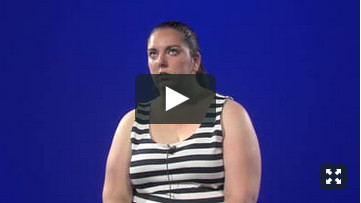Contents
This section provides a selection of case studies, audio and film clips that can be used in conjunction with the exercises on the website.
The video and audio clips feature birth parents, adopters and young people talking about their experiences and feelings on contact after adoption. These are useful as standalone resources and can be used for individual or team learning.
 Film clips: Young people’s views and feelings: letterbox contact
Film clips: Young people’s views and feelings: letterbox contact
 Film clips: Young people’s views and feelings: openness with adoptive parents
Film clips: Young people’s views and feelings: openness with adoptive parents
 Film clips: Young people’s views and feelings: direct contact
Film clips: Young people’s views and feelings: direct contact
 Film clips: Adoptive parents opening contact with birth parents
Film clips: Adoptive parents opening contact with birth parents
These audio clips and transcripts of birth parents talking about various aspects of adoption are intended for use in training and self directed learning to increase practitioners understanding of the needs and feelings of birth relatives. They can be used in the recruitment, assessment and training of adopters to explore the value of communicative openness and increase empathy with birth parents. The clips can also be used in supporting other birth parents to feel less isolated and begin to talk about their own experiences.
These audio recordings of birth parent voices were made by Prof Beth Neil and her research team at UEA as part of their “Helping Birth Families” research study. The birth parents who took part had worked alongside the research team as service user consultants to the project. Further details of the “Helping Birth Families” study can be found on the Adoption Research Initiative webpage.
- Finding hard to obtain support
- Living with adoption in the longer term
- Losing a child to adoption
- The adoption process
The series of audio clips can also be access through the Adoption Research initiative website
Case study: Ava (age 7) and Rory (age 3)
Ava and her younger brother Rory have been in care for 18 months and the plan is now for them to be adopted.
The children were finally removed from their parents following an incident where Rory was injured. He was taken to hospital by his parents who said that he had accidentally fallen out of the back of his dad’s van where he had been playing. The doctors considered that the injuries were not consistent with this explanation and that it was more likely Rory had been hit by one of his parents. Social services have been involved with this family and concerned about the children for some time. The initial referral had been made 3 years ago by Ava’s nursery school because she was often sent to nursery looking dirty and her speech was very delayed. The police had also been called to the family home on a number of occasions because the parents were drunk and arguing loudly. There were concerns that Ava actually did a lot of Rory’s care, feeding him and changing his nappy and the home conditions were described as “pretty squalid”. Although there are many concerns about the abuse and neglect suffered by Rory and Ava, criminal proceedings against the parents are not being taken.
Ava and Rory’s parents are adamant that they love their kids and would never do anything to hurt them. They say that they are admittedly not “house proud” but were trying to improve, and that it would have been better if the social services had given them more help (like sending someone round to do some cleaning, or getting them some more money) rather than just criticising and interfering. The social worker’s view is that the parents do genuinely care about the children and are not deliberately cruel, but they have little understanding of what the children need or how to provide this and they both have issues with alcohol.
On coming into foster care, both Rory and Ava made rapid improvements in their physical health and growth. In terms of their emotional health, at first both children appeared quite withdrawn and frightened. But Ava and Rory’s foster parents are very experienced with troubled children, and the children are continuing to make progress. Rory is now reported to be meeting his milestones, and to be a happy boy who is attached to his foster parents. Ava remains disturbed in her emotions and behaviour at times, particularly at school where she finds it difficult to get on with the other children. She has started to attach to her foster carers, though this attachment has been assessed as being quite anxious.
Whilst care planning and legal proceedings have been underway, the children have had supervised contact with their parents once a week at the family centre. Ava often asks about her mum and dad, and when she will see them next. During contact meetings Ava and her parents always greet each other enthusiastically (in fact the contact worker described the parents’ greeting as “over the top”). The quality of interaction between Ava and her parents however is not good. The contact worker reports that parents don’t seem to be very good at knowing how to talk to or play with the children, and after a while they end up talking to the contact worker about their own issues. Ava has never said that she doesn’t want to go to contact, but after the meetings she is often sick in the car, and she has nightmares on the following nights. The social worker has done some “wishes and feelings” work with Ava and she has said that she would like to see mummy and daddy “a little bit”. Rory shows no interest in his parents, in contact meetings he prefers to stay near the contact worker at all times.
Potential adoptive parents have been found for Ava and Rory and the placement order hearing has been scheduled. These adopters, a lesbian couple, have had quite a positive attitude towards birth family contact from the start of their contact with the agency, saying that they feel it is important that children know where they have come from to prevent them having identity problems in adolescence. They indicated in their assessment that they would consider face-to-face contact with birth parents if that was in the child’s best interests. Looking at Ava and Rory’s situation and history, they are uncertain about what would be best and would like guidance from the professionals.
The birth parents oppose the adoption, but have said that if it does have to go ahead they would like to continue seeing the children at least once per month. There are different opinions amongst the professionals involved in the case as to whether continuing face-to-face contact would be a good idea or not.
Case study: Adopters Helena and Rob
Helena and Rob are a white British couple and they have been married for seven years. Helena works part-time as a teaching assistant and Rob is a carpenter. They have no children and are unable to have children because of infertility issues. They have not pursued the option of IVF because this was a procedure they did not wish to go through and they felt positive about adoption because Helena’s mum (now deceased) was herself adopted. The couple have several nieces and nephews who they spend a lot of time with; she has always enjoyed having children around her hence her choice of career as a teaching assistant. Rob is the same; they are both looking forward to putting their efforts into parenting a child.
Helena described how on embarking on their adoption journey “it didn’t even cross my mind as to what child we would or would not take, just one that needed love; we didn’t have any expectations really on the child, the particular child.” In their adoption assessment, Helena and Rob expressed willingness to accept a broad range of children (up to the age of five), the only exception being a child who had considerable physical disabilities. Because they live in a two-bedroom house, they have been approved to adopt one child.
In discussing birth family contact issues with the social worker, Helena has expressed that she would quite like to meet with a child’s birth parents “for my own curiosity”. Rob has also said he would be quite willing to have such a meeting if required, though he feels no personal need or desire to meet with birth parents. His view is more just that “it’s a different part of the child’s life, it is gone, dusted, done and dusted as far as I am concerned”.
In terms of ongoing contact with the child’s birth family, the couple have said they are happy to respond if birth parents are willing to write them a letter, but they would be unhappy about writing to a birth parent who did not reply as, in Helena’s words “otherwise it has always got to be us that is doing all the chasing the whole time and we don’t want that”.
The couple do not feel positive about the prospect of face-to-face contact with birth parents however, their view being that this is “not fair on the children” particularly when children have not been looked after well by their parents. The couple are worried that such contact is likely to distress a child and would be an unhelpful “interruption” in their life. They feel somewhat more positive about the possibility of sibling contact however, and the couple have mentioned how Helena’s mother regretted not having any contact with her birth siblings after she was adopted.
The couple are “in-house” adopters and they live about one hour away from the town where most of the child’s birth family live.
Case study: Jack (age 15 months)
Jack is of dual heritage – his father is white British and his mother is white/African Caribbean British. The plan for him is to be adopted. He has no brothers or sisters.
Jack’s parents met at a day centre for people recovering from mental illness. His mother has a diagnosis of schizophrenia, and his father has bipolar disorder. His parents’ relationship lasted only a few weeks and Jack’s father left the area before he was born. Jack has never met his father who does not want to be involved in his life.
Jack’s mother was in her mid-30s when he was born. She had been living with schizophrenia since her late teens. Her condition is quite disabling; she has had several admissions to psychiatric hospital over the years. She has not been able to hold down any work, but when she is well she attends local day services where she has made friends and where she particularly enjoys art and craft activities. When she is unwell she becomes very withdrawn and stops looking after herself. She can be resistant to help: her paranoid feelings make her suspicious of other people and she tends to shut herself away in her flat and not answer the door or the telephone. She has no history however of violent behaviour towards other people. She is supported to live in a flat in the community by the mental health community support team.
Jack’s mother had an episode of her mental illness in the latter stages of her pregnancy, and Jack was born in a mother and baby unit in the psychiatric hospital. He was born at 35 weeks gestation weighing 5 ½ pounds and was transferred to the special care baby unit at the general hospital where he stayed for one week.
After one week Jack was well enough to be discharged and he was placed with foster carers whilst his mother remained in the psychiatric hospital. His mother was quite unwell for three months after Jack’s birth, and it was not felt to be a good idea for him to be taken to visit her. When well enough however she was interested in hearing updates and seeing photos provided by Jack’s social worker.
When Jack was three months old his mother moved back home to her flat. Jack remained in foster care but was taken by his foster carers to have contact with his mother twice a week at the local family centre for an hour and a half. Jack’s mother came to these meetings reliably. She was always pleased to see him and enjoyed holding him and playing with him. She did not however feel confident in doing any more than this on the visits. For example if Jack cried or his nappy needed changing she would give him straight back to the foster carer. She seemed overwhelmed by the idea of looking after a baby, and at planning meetings she insisted that she was “not well enough yet” to think about having Jack to live with her. Jack seemed reasonably content on these visits with his mother until he reached the age of six months. He then became clingier to his foster carer and somewhat fearful of strangers, and he often cried when passed to sit on his mum’s lap.
As there seemed no realistic chance of Jack been cared for by his mother, a plan to place Jack for adoption was put forward. Jack’s mother has said that she would not mind if he is adopted as she knows she could not cope with looking after him and she wants him to have a good life. But she has two reservations. Firstly she is worried that she will not be able to have any contact with Jack if he is adopted, and she says that she needs to know how he’s getting on. Secondly she is worried that Jack might think that she doesn’t love him if she signs the adoption papers.
Jack has been in the same foster placement since being discharged from hospital. He seems to have a secure attachment to his foster carers and is meeting all his developmental milestones.
Case study: Lacie (age 5) and Carla (age 4)
Lacie and Carla are the children of Leanne and Darren, part of a larger sibling group of five, all removed from home 13 months ago ( for more information on the family see Mikey’s case study). The two girls are placed with their grandmother. The three young children have been involved in prolonged care proceedings, with high levels of contact throughout.
Whilst in their parents’ care, Lacie and Carla were exposed to drug and alcohol misuse, violence and adult sexual behaviour. Both children have some developmental delay and attachment difficulties. At the time of removal, the girls had matted hair and rough skin. They ate with their hands and were both in nappies. Lacie’s facial expression was blank, but she has gradually started to smile and laugh. Lacie shows a lot of self-comforting behaviour, twiddling her hair and rocking at night. Carla had little speech and relied on Lacie to talk for her. Both children appeared fearful of being bathed and Carla seemed unusually passive during nappy changes. They both flinched at sudden sounds. The girls are sometimes gentle with each other, sometimes controlling and aggressive.
On contact days, Lacie hides her shoes. She is silent and withdrawn on the walk to the contact centre. During visits, Lacie often withdraws to the corner of the room and refuses to eat the food her mother has brought. She is compliant and smiley when Darren initiates play. After visits, Lacie appears exhausted and often sleeps for up to two hours. Carla shows no obvious response before contact. During visits, she seeks her mother’s attention, pushing and shoving Lacie out of the way. Carla throws frequent tantrums, sometimes biting herself. These are worse after contact. During visits, Carla sometimes rubs herself against Darren.
Case study: Mikey Maddox (age 14 months)
The Maddox Family
Mikey is the youngest of five children, all subject to care proceedings. His siblings are Chantelle (13), Alfie (9), Lacie (4) and Carla (3). Care proceedings were initiated shortly before Mikey was born. Mikey was removed at birth and placed with experienced foster carers. The plan for him is adoption. Lacie and Carla are to remain with their maternal grandmother under special guardianship. The older two children will remain in separate long term foster placements.
Mother: Leanne
Leanne is mother to all the children. She is a twenty eight year old white British woman. Leanne has a history of childhood abuse, sexual exploitation and exposure to violence; she spent time in care and became involved in drugs at 14.
Leanne has had little support in raising the children from any of her partners. The older children suffered some neglect, exposure to drug use and possible sex work in the home. The situation deteriorated after Leanne met Darren, father of Lacie and Carla. He was repeatedly violent to Leanne in front of the children and there was drug use and dealing in the home. Darren is a prolific offender with a history of violence and substance misuse. Leanne has threatened to kill herself if Mikey is adopted.
Father: Drew
The five children have four different fathers. Mikey is Drew’s only child. Mikey was conceived as a result of a brief liaison. Drew is a 19 year old black British man who works in the family fruit and veg shop. He finds reading hard. Drew has no criminal convictions and his family is not known to social services. Drew only discovered that he was a father when Mikey was three months old, Leanne having withheld information about Mikey’s paternity. Darren, father of the older children, has threatened to kill Drew more than once. Drew does not feel able to take on the responsibility of bringing up Mikey as a single parent. Drew’s mother Mel can only offer limited support because she has a disabled adult son and cares for Drew’s father, who has severe arthritis. Mel has helped Drew to make the difficult decision to support adoption for his son.
Mikey
Mikey has lived with foster carers Sue and Jane since birth. He was a small baby and showed some minor drug withdrawal symptoms, but is now thriving. Mikey is very close to the carers’ grown up son, Leo and shrieks with excitement when he comes in. The other child in placement, Roxanne, is two months older than Mikey. The two children laugh a lot together and tend to play alongside each other. Mikey loves the family dog and enjoys trips to the park with Sue’s Dad, who he calls ‘Gann’.
Current Contact
Mikey has contact with his mother three times a week and with his father once a week. On Fridays, the older children join maternal contact after school.
Leanne usually attends contact regularly, but there have been periods when she is late or phones to say that she is ‘unwell’. Sometimes Leanne appears unkempt, bruised or fragile during contact, shivering and pale. She has to be reminded to switch her phone off and seems pre-occupied with ensuring that Darren gets the contact he ‘is entitled to’. Mikey appears content but a little subdued during visits to his mother, often falling asleep in Leanne’s arms. Leanne is gentle and tender with Mikey, kissing and caressing him, constantly telling him she loves him. She can find it difficult when Mikey wants to be off playing, rather than sitting on her lap. Mikey shows no distress at the end of visits to his mother and will sometimes get his coat and bring it to her.
Drew was initially awkward and self-conscious during his visits to Mikey, having little experience with young children. With support from the supervisor, he has begun to relax and now spends time playing hide and seek, enjoying chasing games and helping Mikey ride a trike around the garden. Mikey is animated when he sees his father, shrieking with joy and holding his arms out. There is a lot of shared laughter and Mikey snuggles up to Drew as they look at picture books. Drew’s Mum, Mel, sometimes comes along. She brings home cooked food and sings songs from her own Jamaican childhood. Mel has provided lots of photos for Mikey’s life story book and gave him a hand-made quilt at Christmas.
The information and contact contracts provided for everyone involved in these arrangements are below.
Case study: Mikey (age 13 months), Lacie (age 5) and Carla (age 4)
Leanne is the mother of all three children. Lacie and Carla’s father is Darren. Mikey’s father is Drew (he was conceived as a result of brief liaison when Darren and Leanne had split up temporarily). Mikey has been in foster care since birth. The girls have been placed with their grandmother. These three young children have been involved in prolonged care proceedings, with high levels of contact throughout.
Whilst in their parents’ care, Lacie and Carla were exposed to drug and alcohol misuse, violence and adult sexual behaviour. Both children have some developmental delay and attachment difficulties. At the time of removal, the girls had matted hair and rough skin. They ate with their hands and were both in nappies. Lacie’s facial expression was blank, but she has gradually started to smile and laugh. Lacie shows a lot of self-comforting behaviour, twiddling her hair and rocking at night. Carla had little speech and relied on Lacie to talk for her. Both children appeared fearful of being bathed and Carla seemed unusually passive during nappy changes. They both flinched at sudden sounds. The girls are sometimes gentle with each other, sometimes controlling and aggressive.
On contact days, Lacie hides her shoes. She is silent and withdrawn on the walk to the contact centre. During visits, Lacie often withdraws to the corner of the room and refuses to eat the food her mother has brought. She is compliant and smiley when Darren initiates play. After visits, Lacie appears exhausted and often sleeps for up to two hours. Carla shows no obvious response before contact. During visits, she seeks her mother’s attention, pushing and shoving Lacie out of the way. Carla throws frequent tantrums, sometimes biting herself. These are worse after contact. During visits, Carla sometimes rubs herself against Darren.
Mikey
Mikey has lived with foster carers Sue and Jane since birth. He was a small baby and showed some minor drug withdrawal symptoms, but is now thriving. Mikey is very close to the carers’ grown up son, Leo and shrieks with joy when he comes home from work. The other child in placement, Roxanne, is two months older than Mikey. The two children laugh a lot together and tend to play alongside each other. Mikey loves the family dog and enjoys trips to the park with Sue’s Dad, who he calls ‘Gann’.
Mikey appears relaxed and content during visits to his mother, as a baby he often slept in her arms. He is now content to explore the playroom in the contact centre or sit on his mother’s lap when he is tired. Mikey shows no obvious distress at the end of contact, sometimes fetching his coat and handing it to his mother. Leanne is gentle and tender with Mikey, kissing and caressing him, telling him she loves him. She hugs him tightly at the end of visits. Mikey tries to wriggle away and puts his arms out towards his foster carers.
Personal history: Adopted adult Sarah explains the story behind her song ‘History’
By the time my son was 18 months old I knew everything about him – every inch of his skin, what songs he liked me singing, how to stroke his little head to help him sleep, how he was afraid of people dressed up or toys with eyes that move, how old he was when he rolled over, crawled, cruised, walked, how baths calmed him after days when his brain was over stimulated, how he loves our dog, I could go on and on. These are the stories I will share with him forever- along with those of the months he grew inside me- how when he got hiccups I’d feel relieved because I knew he was ok, how when he was born I just gazed at him amazed by how perfect he was, I will tell him where his name came from, of how his middle name is a family tradition…
When I was 18 months I went to live in foster care. The day that happened, I lost my history.
I have been through periods of wanting to search, to fill in the blanks, to add the missing chapters to the book of my life. Life just takes over, ‘not now’, I’d say, ‘maybe later’… when I’ve done exams, gone to uni, moved home, got married, had a baby…. time slips on. I search on Facebook, ‘how do I spell her name?’ – nothing. Long lost family is about Dads today. I googled him. I found an obituary.
Panic, what if that happens to my birth Mum? Time slips on. Back from holiday a year later, a message is left on my machine. A birth aunt had called the local authority to let them know my birth mother had passed away suddenly. I finally find her Facebook page. Filled with messages looking for her birth children, searching, loving, messages on birthdays, stories of memories. There were more in their minds. Now they’re gone. I’ll never know. I missed the funeral by 5 minutes because the director thought that everyone was there. I never even got to say goodbye.
Film clips
Film clips of adoptive parents
Adoptive parents opening contact with birth parents
Film clip: Liz, an adoptive mother, talks about her family’s experience of opening contact with birth relatives
Also viewable online via Adobe Connect
In this film, Liz shares her experience of contact following the adoption of her son. When the placement for adoption was first made the arrangement was for indirect contact (through letterbox). This worked well and built a foundation of trust.
After a few years, the adopted child asked his parents if he could see the grandparents who had kept in touch with him through indirect contact. The adopters discussed this with their social worker and a plan was made for a supported face to face meeting. Face to face contact continued to develop from this point. The adopted child is now in his teens and contact has gradually become fully open with visits to each others’ homes two or three times a year and other birth family members involved occasionally.
The film is divided into sections, covering several aspects of contact including: role of adoptive parents in supporting their child during and after contact, finding information on birth parents trough social media, contact plans and support, and benefits and challenges of contact.
The film may be viewed as a whole or used to illuminate or prompt discussions on specific points, particularly during adopter training. Download the film notes (PDF 274KB) with timings here.
Film clips: birth relatives and adopter experiences
Birth relative and adopter on meeting each other for the first time
In this clip a birth grandparent and an adoptive mother discuss the experience of meeting each other. The grandmother talks about her hopes and concerns with the adoption process and how meeting the adoptive family helped her.
Birth relatives discuss support needs
A birth grandmother discusses her feelings on the adoption of her grandson and support needs for birth families.
Families’ experience of direct contact
An adoptive mother and birth grandmother discuss their experience of direct contact and the practical aspects of meeting.
We both had the same goal in mind. An adoptive mother and a birth grandmother discuss their experience of contact.
Clips taken from the longer film version are above, where a birth relative and adopter discuss specific issues.
Download the notes for this film PDF (328KB)
Film clips of young people
Young people’s views and feelings: letterbox contact
Listen to three adopted children talk about their experience of letterbox contact, how they and their families have managed contact and what influence it has had on their life and identity.
Also viewable online via Adobe Connect
Young people’s views and feelings: openness with adoptive parents
Listen to four adopted children talk about their relationship with adoptive parents, what has been important to them and how their adoptive parents have supported contact (both letterbox and direct contact) and the adoption process.
Also viewable online via Adobe Connect
Young people’s views and feelings: direct contact
Listen to two adopted children talk about their experience of direct contact, how they and their families have managed contact and what influence it has had on their life and identity.
Also viewable online via Adobe Connect
Young people’s views and feelings (full version)
Audio clips
- These audio recordings of birth parent voices were made by Prof Beth Neil and her research team at UEA as part of their “Helping Birth Families” research study. The birth parents who took part had worked alongside the research team as service user consultants to the project. Further details of the “Helping Birth Families” study can be found on the Adoption Research Initiative webpage.
- Finding it hard to obtain support.

Download the audio file as an MP3 (4MB)  Living with adoption in the long term.
Living with adoption in the long term.- Download the audio file as an MP3 (5.5MB)
 Losing a child to adoption.
Losing a child to adoption.- Download the audio file as an MP3 (5MB)
 Birth relatives talking about the adoption process.
Birth relatives talking about the adoption process.- Download the audio file as an MP3 (4MB)
- Finding it hard to obtain support.
- Transcripts of birth parents talking about:




